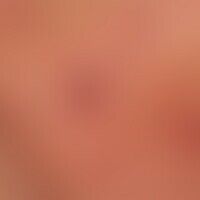Image diagnoses for "Macule"
325 results with 1215 images
Results forMacule

Hypomelanosis ito Q82.3
Hypomelanosis Ito: Striped and extensive depigmentation, no other symptoms, no other organic malformations.

Acromegaly E22.0
Acromegaly: 43-year-old patient with known acromegaly. Noticeable increase in size of the lower extremities. Simultaneous development of excessive varicosis with consecutive chronic venous insufficiency (CVI).

Vasculitis leukocytoclastic (non-iga-associated) D69.0; M31.0
Vasculitis leukocytoclastic (non-IgA-associated): small spotted vasculitis of both lower legs.

Striae cutis distensae L90.6

Tinea inguinalis B35.6

Half-and-half nails L60.8
Half and half nail: Zonal, slightly blurred white coloration of the proximal and brown coloration of the distal nail plate; no underlying disease known.

Vasculitis leukocytoclastic (non-iga-associated) D69.0; M31.0
Vasculitis, leukocytoclastic (non-IgA-associated). large hemorrhagic blisters on bled erythema on the lower leg, interspersed with petechiae.

Chilblain lupus L93.2
Chilblain lupus: extensive, painful redness of the plantar side of several toes.

Vitiligo (overview) L80

Erythema infectiosum B08.30
Erythema infectiosum: generalized exanthema with larger and smaller, in its complete manifestation about 3.0 cm in diameter, less symptomatic, on the surface slightly roughened, anular erythema.

Vitiligo (overview) L80
Vitiligo: irregularly limited vitiligo zone marked by arrow with melanosis of the small labia.

Argyria L81.8
Argyrie: diffuse, grey to greyish-blackish, metallically shiny, diffuse discolouration of the facial skin due to deposition of silver complexes The patient worked for decades in a silver-processing company

Vitiligo (overview) L80
Vitiligo: (Detail enlargement): Multiple, since adolescence occurring, size-progressive, flat, partly bizarrely limited, bright spots on mamma and in the sternum area of a 28-year-old woman. The left areola mammae (areola) is largely depigmented.

Klippel-trénaunay syndrome Q87.2
Klippel-Trénaunay syndrome: extensive vascular malformation with extensive nevus flammeus affecting the trunk and both arms. So far no evidence of soft tissue hypertrophy. No AV fistulas.

Becker's nevus D22.5
Becker-Naevus: Since birth existing, extensive hyperpigmentation in the area of the right hip in a 7-year-old boy; typical for the Becker-Naevus is the bizarre bordering as well as the follicular accentuation in the pigment zones.

Nevus anaemicus Q82.5
naevus anaemicus: congenital, irregularly dissected white, smooth stains at the edges. no reddening after rubbing the stain. on glass spatula pressure the boundaries to the surrounding area disappear.

Striated leukonychia L60.8
Leuconychia striata: White horizontal stripes of the nails in the presence of the Sezary syndrome; above the white bands, flat, discrete leukonychia.

Phlebectasia I83.9
Phlebektasia. Small, tortuous vascular dilatations on the neck of a 70-year-old patient. Extremely dry skin.






